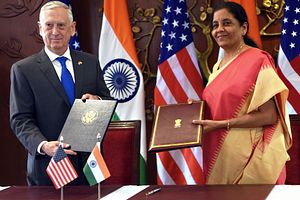A dialogue involving both the two foreign and defense ministers of two countries is a diplomatic format reserved for the closest strategic partnerships. The U.S and India concluded their first-ever “2+2” ministerial-level dialogue on September 7.
In recent years India has established lower-level 2+2’s with Australia, Japan, and South Korea, but never have those talks involved the nations’ premier foreign affairs and defense officials.
This month’s dialogue therefore marks an important milestone in the strengthening of the India-U.S. partnership. More than that, it produced concrete results. The most important outcome was the signing of a Communications, Compatibility and Security Agreement (COMCASA) — a major defense achievement. A variation of the Communication Interoperability and Security Memorandum Agreements (CISMOA) Washington has with other foreign partners like France and Singapore, the COMCASA allows the U.S. to transfer secure communications and data equipment to India. It also allows the U.S. to offer real-time data-sharing with the Indian military over secure channels.
The 2+2 produced other meaningful agreements as well. For example, the two nations agreed to:
- Advance cooperation between America’s Defense Innovation Unit and the Indian Defense Innovation Organization.
- Set up hotlines between the U.S. Secretary of State and India’s External Affairs Minister and between the U.S. Defense Secretary and India’s Defense Minister.
- Station an Indian naval attache with U.S. Central Command in Bahrain, and
- Hold a new bilateral, tri-service military exercise in 2019.
The parties also renewed their commitment to enhance the Defense Technology Trade Initiative (which encourages joint development and co-production between the two countries’ defense establishments) and seek membership for India at the Nuclear Suppliers Group (NSG), an international body that governs the trade of nuclear materials. (China has opposed India’s entry).
These agreements complement earlier moves by the Trump administration to strengthen Indo-U.S. ties. Prior to the 2+2, the administration had eased restrictions on high-end defense exports to New Delhi by granting India Strategic Trade Authorization-1 authority. It also had entered an agreement governing Helicopter Operations from Ships other Than Aircraft Carriers,authorized a $1.8 billion arms deal to sell India 24 Sikorsky helicopters, and approved the joint production of F-16 fighter jet wings in India. The Trump administration has also brought the U.S. and India further into alignment by adopting a firmer approach toward Islamabad and repeatedly criticizing China’s Belt and Road Initiative.
The Crown Jewel
Undoubtedly, the crown jewel of the 2+2 dialogue was the finalization of COMCASA. India has had to overcome significant internal resistance to entering “foundational” military pacts with the U.S. Its Cold War philosophy of “Non-Alignment” and aversion to foreign partnerships has faded since the collapse of the Soviet Union, but not vanished entirely.
Delhi remains fiercely committed to maintaining its “strategic autonomy,” and influential Indian interest groups are wary of dependence on foreign powers and any initiatives resembling a military alliance. This is why it took over a decade of negotiations before Delhi would sign, in 2016, the Logistics Exchange Memorandum of Agreement with Washington—an agreement similar to those already entered into by 88 other countries.
Fortunately, Prime Minister Narendra Modi’s government has proven more willing than its predecessors to push the boundaries of strategic cooperation with the U.S. Still, India insisted on several amendments and provisions to the standard CISMOA agreement.
For example, under the terms of the deal, the pact is valid for only 10 years and can be terminated with six-month’s notice. Moreover, the U.S. cannot “turn off” any encrypted communications systems while the pact is valid, nor can it share any data obtained from Indian platforms with third parties without India’s consent.
Ultimately, the benefits of a COMCASA arrangement with the U.S. were too significant for India to ignore. To date, the U.S. has been forced to remove advanced communication equipment from military platforms sold to India. This meant that, during joint exercises, the U.S. had to place temporary systems on Indian units so the two sides could communicate — albeit through less secure channels. At least one Indian press report suggests the unprecedented standoff between Chinese and Indian border forces on the Doklam plateau in the summer of 2017 signaled a “turning point” for Delhi and greater awareness of the benefits of sharing real-time intelligence with the U.S.
Most immediately, COMCASA will allow the U.S. to provide India with advanced Sea Guardian drones, complete with “COMCASA-protected equipment like an advanced [GPS], [IFF] receiver and VHS system, which is immune to jamming and spoofing from enemies.”
Looking ahead, the U.S. and India have one final “foundational” military agreement left to negotiate: a Basic Exchange and Cooperation Agreement to facilitate sharing of geospatial intelligence. This month’s successful 2+2 should pave the way for smoother, speedier negotiations on that front. As Prime Minister Modi declared in June 2016 when the U.S. designated India a “Major Defense Partner,” it appears the two sides have finally “overcome the hesitations of history.”
































